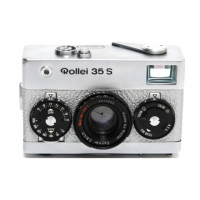Practical
Hints
[Return to Manual index 1 [Previous page 1
[N
ext page 1
9.
Correct
exposure
As a basic rule, al ways point the camera while taking exposure readings exactly in the direction
of
the
subject. Inadvertent til ting
of
the camera - for example, into the sky while taking landscape views - can
falsify the reading and in this case lead to under-exposure.
The exposure meter evaluates the average brightness
of
the measured subject field. With.subjects
of
average contrast it automatically indicates the correct exposure. But even with shots
of
considerable
brightness range you can take the readings in such a way as to ensure correct exposure for the main
subject.
Normal subjects: the view is lit from the front or at an angle from the side. There are no heavy shadows,
and dark and bright areas are balanced. (This uniform front lighting also yields the most saturated colours
in colour shots).
Result: The measured exposure is correct for the who
le
field
of
view.
A special case: The main subject contrasts strongly in brightness against
the background. For example, with a portrait
of
a suntanned face against .,
...
•
•..
·
~
·
·
bright clouds an average reading would give too much importance to the
sky. Y et it
is
the head which matters for the exposure.
~------
------~~~~
The
right
way: Take a close-up reading with the camera near the subject
until the main object completely fills the finder. After setting the exposure
go back for shooting to the previous viewpoint.
Substitute reading:
If
a close-up reading is not possible, point the camera
at a substitute object
of
average contrast and under the same lighting. Use the setting obtained for the
exposure.
Against the light: When shooting against the light open the lens aperture by one stop (next lower
f/number).
For
colour subjects to be
taken
on reversai colour film: A void very great brightness differences. A
close-up reading
of
the shadow areas usually leads to excessive exposure for the sunlit image portions,
which then appear too light and
bumt
out when you project the slide. An average brightness reading (as
with normal subjects) here again yields pictures which correspond most closely to the natural colour
0 0
1mpresswn.
[Return to Manual index
1 [Previous page 1
[N
ext page 1
All
this informations, texts,
and
Images were extractedfrom the "Rollei 35/
35T
/
35S
In Practical Use"
and
only in tends to give sorne orientation to new
us
ers that didn 't
had
access to the original manual. (c)
Rollei-Werke Franke
& Weidecke

